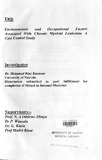| dc.description.abstract | Background: The relationship between Chronic Myeloid Leukemia and broad range of
exposures to occupational, environmental and lifestyle factors known to cause leukemia
in general is limited. CML is by and large incurable and treatment is just palliative and
life prolonging, with high case fatality rate, even in the best centers. Furthermore treatment is very expensive. Identification of leukemogenic factors is therefore important
as they could easily be prevented through simple public health interventions.
Objective: The objective was to determine key environmental, occupational and lifestyle
exposure factors that may be associated with Philadelphia chromosome positive chronic myeloid leukemia (CML).
Methods: A case control study involving Philadelphia positive Chronic Myeloid
Leukemia cases enrolled in GIPAP clinics at the Nairobi and Aga Khan University
Hospitals and two control groups for each case, matched for age and sex: a family and a
hospital based control was carried out.
One hundred and eight cases with age and gender matched family and hospital based
controls were recruited and a standard questionnaire was administered. Individual data on demographics, occupational, environmental and exposures to chemotherapeutic agents, use of smoking and alcohol and family history of cancer were obtained. Clinical
examination was carried out in control subjects. Statistical analysis was done using
bivariate and multivariate analysis to look for associations between exposure factors and CML.
Results: The median age at diagnosis of CML cases was 41.32 years with age range of 8- 81 years and a male; female ratio of 1.7: 1. Most of our cases were concentrated in or
around Nairobi. There was no significant correlation found for exposure to benzene or
pesticides. Long duration of exposure to pesticides in the family control group was
significantly associated (t-test, P=0.017) with risk of CML. The use of piped water suggested a protective effect in family control with OR=0.49(95%CI=0.26-0.93 P=0.03),
and a trend of risk in use of well water, (OR= 1.67 95%CI=0.96-2.88 P=0.07). There was
risk of CML suggested with having lived in timber houses, in the family controls,
OR=1.85 (95%CI =0.98-3.50 P=0.056), while living in mud houses was suggested to be
10 protective in hospital controls, (OR=0.45 95%CI= 0.24-0.87 P=0.016). Exposure to
abdominal radiography was positively associated with CML and attained significant
levels in both groups, even after regression analysis, Family-OR=9.12 (95%CI-0.080-
0.502 P=0.003), Hospital-OR 9.12 (95%CI-1.716-48.484 P=0.010), with mean duration
of 5.27 ± 6.84 years, median of 3 years, prior to diagnosis of CML. More cases were
exposed to radiographic investigations than controls. Family history of cancer, smoking
and alcohol consumption were not found to be associated with CML.
Conclusions: Associations between exposures to organic solvents like pesticides,
creosote in timber preservation, chloride compounds used in water treatment and
Ph+CML were indicated but were not entirely consistent. Risk of developing CML was
suggested with exposure to plain abdominal radiography. Nevertheless, for almost all
cases of Ph+CML, other explanations must be sought for. | en |
| dc.description.department | a
Department of Psychiatry, University of Nairobi, ; bDepartment of Mental Health, School of Medicine,
Moi University, Eldoret, Kenya | |

